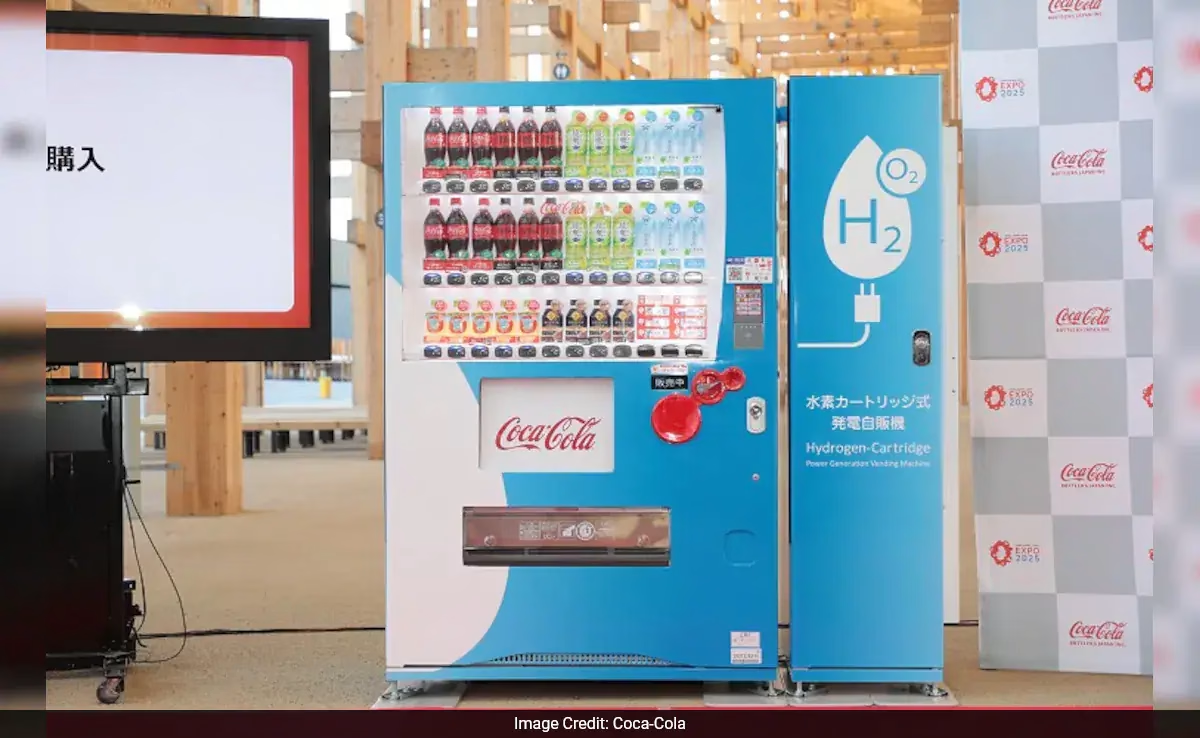Coca-Cola, one of the world’s largest beverage companies, has taken a major step toward sustainability by introducing hydrogen-powered vending machines in partnership with Fuji Electric. This revolutionary innovation marks a shift towards eco-friendly retail solutions, helping reduce carbon emissions and dependence on traditional electricity sources.
With climate change concerns rising and businesses striving to reduce their environmental impact, Coca-Cola’s move signals a strong commitment to green energy solutions. But what makes hydrogen-powered vending machines unique? How do they work? And what impact will they have on the future of retail and sustainability?
In this blog, we’ll break down everything you need to know about Coca-Cola’s hydrogen-powered vending machines, including their working mechanism, benefits, challenges, and future scope.
How Do Coca-Cola’s Hydrogen-Powered Vending Machines Work?
Traditional vending machines rely on electricity, which often comes from fossil fuels, contributing to carbon emissions. These new hydrogen-powered vending machines replace conventional energy sources with a hydrogen fuel cell system that generates electricity with zero emissions.
The Hydrogen Fuel Cell Process Explained
🔹 Hydrogen Storage: The vending machine stores compressed hydrogen in a special fuel tank.
🔹 Electrochemical Reaction: Inside the hydrogen fuel cell, hydrogen reacts with oxygen from the air to produce electricity.
🔹 Zero Carbon Emissions: The only byproduct of this reaction is water vapor, making it a clean and green energy source.
🔹 Continuous Power Supply: The vending machine operates independently, without relying on an electrical grid.
This self-sufficient energy system not only reduces electricity costs but also ensures the vending machine can operate in remote locations and during power outages.
Why Is Coca-Cola Investing in Hydrogen-Powered Vending Machines?
Coca-Cola operates millions of vending machines worldwide, consuming a huge amount of electricity. Transitioning to hydrogen-powered vending machines aligns with Coca-Cola’s global sustainability strategy and carbon neutrality goals.
Here are the key reasons behind this major investment:
1. Reducing Carbon Footprint
✅ Traditional vending machines consume a lot of electricity, which often comes from fossil fuels, increasing CO₂ emissions.
✅ Hydrogen-powered machines generate clean energy, with zero carbon emissions.
✅ This initiative supports Coca-Cola’s goal of achieving net-zero emissions in the coming decades.
2. Energy Independence & Disaster Preparedness
✅ Hydrogen-powered vending machines can operate without a grid connection, making them ideal for remote locations.
✅ In case of natural disasters, where power outages are common, these vending machines can continue running.
✅ Coca-Cola has previously deployed solar-powered vending machines, and this new technology further strengthens its sustainability strategy.
3. Leading the Green Energy Revolution in Retail
✅ Coca-Cola is setting a new industry standard for sustainable vending solutions.
✅ With growing consumer awareness about climate change, sustainable initiatives boost brand reputation.
✅ By investing in hydrogen technology, Coca-Cola is inspiring other retail brands to adopt clean energy solutions.
What Are the Key Benefits of Hydrogen-Powered Vending Machines?
✅ 1. 100% Clean Energy with Zero Carbon Emissions
Unlike traditional vending machines that consume electricity from coal-powered grids, hydrogen-powered vending machines generate electricity without emitting CO₂. The only byproduct is water vapor, making it a truly eco-friendly solution.
✅ 2. Independent Power Supply (No Grid Dependency)
These vending machines don’t need a traditional power connection, making them ideal for:
- Off-grid locations (parks, highways, rural areas).
- Disaster-prone areas where power failures are frequent.
- Temporary events and festivals that require mobile vending solutions.
✅ 3. Cost-Effective in the Long Run
While hydrogen fuel cells have higher initial costs, they significantly reduce long-term electricity costs. Over time, as hydrogen production becomes cheaper, these machines will become even more cost-efficient.
✅ 4. Supports a Hydrogen Economy
By adopting hydrogen-powered vending machines, Coca-Cola is helping accelerate the development of a hydrogen economy, encouraging more industries to invest in hydrogen fuel technology.
Challenges & Roadblocks in Implementing Hydrogen-Powered Vending Machines
While hydrogen-powered vending machines offer significant benefits, some challenges must be addressed before widespread adoption.
❌ 1. High Initial Cost
- Hydrogen fuel cells are expensive compared to traditional electricity-powered vending machines.
- The cost of hydrogen production, storage, and distribution is still relatively high.
❌ 2. Hydrogen Storage & Infrastructure
- Unlike electricity, hydrogen requires specialized storage tanks.
- There are limited hydrogen refueling stations, making large-scale adoption difficult.
❌ 3. Safety Concerns
- Hydrogen is highly flammable, requiring strict safety measures for vending machines to prevent accidents.
Despite these challenges, technological advancements and growing investments in hydrogen energy are expected to make these vending machines more practical and widely available in the coming years.
Future Scope: Will Hydrogen-Powered Vending Machines Become the Norm?
While hydrogen-powered vending machines are currently in their early stages, they have huge potential to revolutionize the vending industry.
1. Expansion to Other Markets
Currently, Coca-Cola is focusing on Japan, a country that has already invested heavily in hydrogen energy. If successful, we can expect these vending machines to expand to more regions, including Europe, North America, and Asia.
2. Integration with Other Renewable Energy Sources
Future vending machines might combine hydrogen fuel cells with solar energy, making them even more sustainable and efficient.
3. Adoption by Other Brands
If Coca-Cola’s hydrogen vending machines prove successful, other major brands like Pepsi, Nestlé, and Unilever might follow suit, making hydrogen vending machines a mainstream solution.
Final Thoughts: Is Coca-Cola Leading a Green Energy Revolution?

Coca-Cola’s hydrogen-powered vending machines are a significant step toward a more sustainable future. By reducing carbon emissions, eliminating grid dependency, and pioneering clean energy solutions, Coca-Cola is setting a new benchmark for sustainability in retail.
🌱 Will hydrogen become the future of vending machines?
🚀 Can Coca-Cola’s initiative inspire other brands to go green?
Only time will tell. But one thing is certain—sustainability is no longer an option, but a necessity, and Coca-Cola is making sure it stays ahead in the game.
Read More : MacBook Air M4 Review: A Powerful Upgrade or Just an Iteration?
FAQs
Where will Coca-Cola’s hydrogen-powered vending machines be installed first?
Coca-Cola’s initial deployment will likely take place in Japan, where hydrogen infrastructure is already developing rapidly. Other regions may follow based on the project’s success.
Will hydrogen-powered vending machines completely replace traditional vending machines?
Not immediately. Hydrogen-powered vending machines will gradually complement Coca-Cola’s existing vending network, alongside solar-powered and energy-efficient vending machines. Over time, as hydrogen fuel cell costs decrease, these machines might become more widespread.


